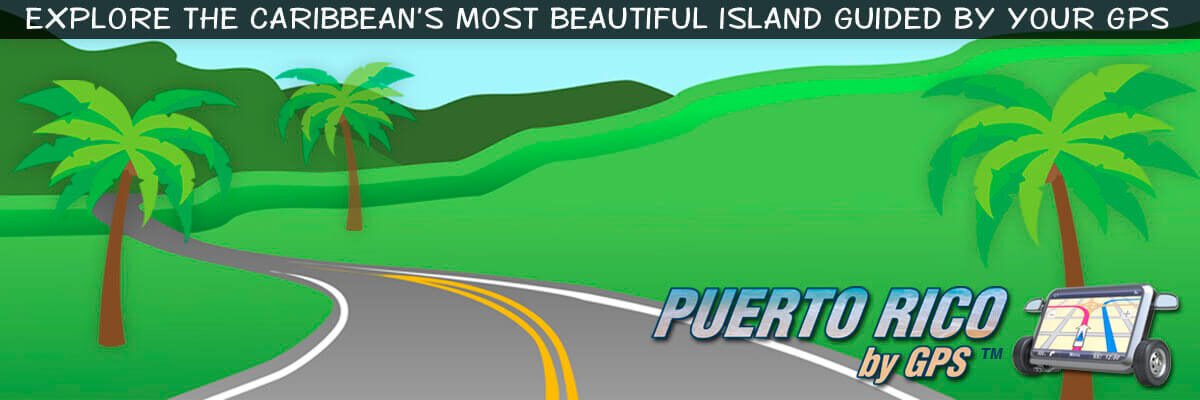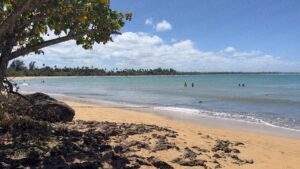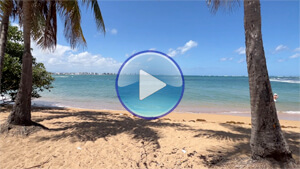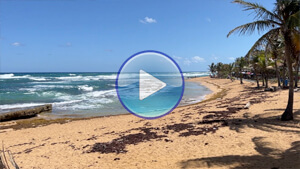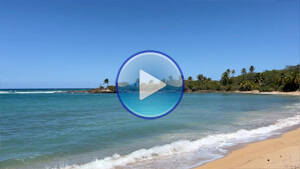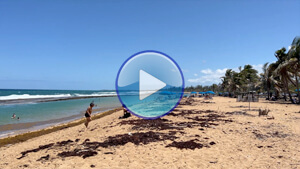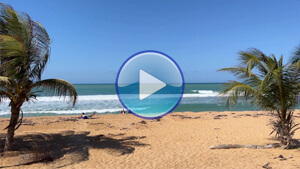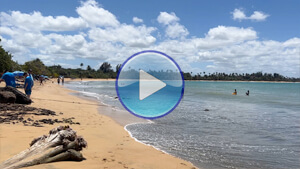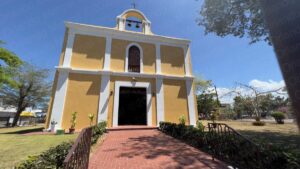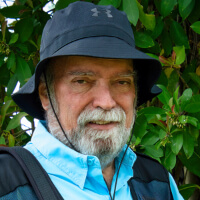Let’s face it, most tourists visit Puerto Rico for the beaches. And Puerto Rico has beaches all around it. After all, it’s an island. So from here on you can replace the word “destinations” with the word “beaches”.
Now that we have that out of the way, let’s set another thing straight: “not all beaches in Puerto Rico have been created equal”. Sure, they all have water, sand and sun. But that’s probably where the similarities end. In theory, all beaches in Puerto Rico have been in the public domain since 1886, when the Spanish government (the ruling colonial power at the time) enacted the Law of Ports. But in practice it’s another matter.
Many hotels and condos have been built along the shoreline. That makes it difficult, or impractical, for the people to access many of the Island’s best beaches. In other cases the government has built “balnearios”, that are supposed to be for everyone, but also come with rules and restrictions.
Then you have what I jokingly call “beaches beaches” in my book “Puerto Rico Beach By Beach”. These are the beaches that many of the locals visit. But there’s a catch. They don’t come with amenities. They have no buoys, lifeguards, gazebos, showers, bathrooms, concession stands or parking areas.
It’s just you and nature (and the couple of other hundred people that might just happen to be there). So I guess this is the part where I tell you that “if you decide to visit any one of the beaches that I’m going to mention in this post it’s totally up to you. I’m not encouraging you, recommending any of them or in any way responsible for what might happen to you”.
During the last week of March my wife and I visited the Piñones area in the town of Loíza, Puerto Rico. We meant to cover the entire municipality, like we’ve done with other towns for our series “5 Must-See Places in the town of XXXX”, but we wrote to the mayor’s office and received no response. Like I’ve said in the past, these things are a lot easier when you have someone from the municipality to show you around and point you in the right direction.
When you don’t, you just do your best and let the chips fall where they may.
One of the most attractive areas in the entire town of Loíza has always been the Piñones sector. When I was a young man I used to drive by this area on Sunday afternoons to enjoy the shoreline and an ocasional “fritura” with an “adult” beverage. Today it’s entirely a different scenario.
Sure, the beaches are still there; and they’re wild and beautiful like God intended, but there are buildings everywhere. So much so that in many cases you can’t even see the coast.
And if you’re asking yourself “what’s a fritura?”, it’s a type of fried food made to be eaten on the go. As for the “adult beverage” I’m sure we’re all on the same page with that one.
Boca de Cangrejos and the Food
My wife and I arrived in Piñones around 10:00am and went straight to the Boca De Cangrejos shoreline. This is a small beach that’s just behind the restaurant area that you find on your left immediately as you pass the bridge that joins Loíza to the town of Carolina. If you’re still not clear where that is, there’s a map at the end of this article with the GPS coordinates to every location mentioned.When I was a young man this entire area was a pine forest. Not like the ones you would find in the Rocky Mountains or Yellowstone, but tropical pines. My friend and I would often go there on Sundays, park under the trees, wax our cars, have a beer and check out the girls. Today there are dozens of restaurants, trash in every corner and you can hardly see the shore. And forget about the pines. Those were killed years ago.
As for the food, let me just say (and I’ll try to be nice) that it’s not the best representation of Puerto Rican “frituras”. First, many of the people concocting the food aren’t even Puerto Ricans. And second, most of what you’ll find has been sitting under a light bulb for hours. That makes for mushy food soaked in overused grease.
My wife and I ordered a couple of those monstrosities and ended up throwing them in the trash. Hours later we had upset stomaches.
This isn’t to say that you won’t find genuine high quality “frituras” anywhere in this area. Of course you will, but you’ll have to know what to look for. And here’s a hint: “find a place with a long line and a person actually frying the food as he/she sells it. The long line will usually means that their food is good. Why else would people put up with a long line? And the fact that you’re getting the food right out of the boiling oil guarantees that it won’t be mushy.
As for the Boca de Cangrejos Beach, it’s a small beach where many of the locals go. It’s also next to the mouth of the Blasina Channel that reaches the sea next to the Cangrejos Yacht Club.
I used to fish in that area when I was a young man, so experience taught me that there’s always a strong current going in or out of the channel, depending on the tide. Most of this beach is rocky with only a small area to bathe in.
Locals go there because they know how the water behaves, but if you ask me, I wouldn’t recommend it.
From there we drove 2–3 miles, along road 187, until we reached the famous Vacia Talega beach. There are 4 other beaches along this stretch of road that I’ll cover next. There’s also a trail, covered in blacktop, that connects all the beaches. But here are a couple of things to keep in mind before you “walk it”.
- Consider your Health — You’ll be walking 2–3 miles under the blistering Puerto Rican sun, so make sure to wear confortable shoes, light-colored clothing, a wide brim hat and lots of sunblock. Carry a water bottle too. And remember, those miles that I was talking about are one-way. You’ll have to return.
- Trail Conditions — The government has done a poor job of maintaining the trail, so in some areas you’ll find overgrown vegetation and broken pavement.
- Mosquitoes — Many areas along the trail are covered in mangrove and where there’s one there’s the other.
- Cyclists — Many locals and tourists ride this trail rather than walking it, so be mindful of your surroundings.
All this said, if you really want to experience this area (or at least part of it) walking is your best bet.
Piñones Waterfront
Many people believe that this entire area gets its name from the Piñones beach. But that’s actually a mistake. The beach actually gets its name from the Piñones forest that used to cover most of the area.Today urban sprawl has decimated a large portion of the forest and most people associate the name with the beach.
The Piñones Waterfront makes for excellent eye candy. You won’t find a better place to shoot those wonderful tropical beach pictures. But this is actually the North Atlantic Ocean, with all its might, rocky bottom and underwater currents.
Like the Boca de Cangrejos area there are restaurants everywhere. So much so that they have taken over the area and it’s hard to find a clear view of the coast anywhere.
Many of those places of business started as little shacks that didn’t conform to government regulations or permits. Some still don’t. And some are just ruins of what repeated hurricanes have left along the years. We also observed a lot of trash and graffiti.
Finally, you have the noise levels. This was something that we observed in the Boca de Cangrejos area as well. Some establishments have the music so loud that it’s hard to hear your own thoughts. Let alone each other. Don’t these vendors know that annoying patrons is hardly a way to attract them?
La Torre Beach
When I was a young man this beach would be next to the road. People would park on the edge of the road, enjoy the view and buy at the local food stands.Today it’s still next to the road, of course. But now you can’t park. There’s a double railing along the entire beach that seems to say “keep going”, “don’t stop here”. And people don’t.
I went by “La Torre” on three different occasions while I was producing the video and there was never anyone there. I found this odd because, at first glance, this seems like a very nice beach, with clean tan sand and hardly any rocks.
But the fact that there’s never anyone there should tell us something. After all, this is the open North Atlantic Ocean we’re talking about, so currents and high surf can be a factor.
La “Pocita” Beach
In Spanish a “pocita” is a pond or pool. And that’s exactly what you’ll find at “la pocita” beach. It’s a long beach with a reef just as long that extends along the beach forming a pond. People love this beach, especially mothers with young children, because the water inside the “pocita” is crystal clear and calm.Beyond the “pocita” is another matter. We were told by the locals that some people have drowned while attempting to go beyond the reef into the Atlantic waters. You don’t have to be a genius to figure that one out. All you have to do is look at how the water hits against the reef to know that it takes a moron to go beyond “la pocita”. But I guess there’s a few of those around.
This beach can get quite busy during the weekends. There are street vendors that rent beach chairs and large umbrellas. Some sell “frituras” as well. Parking is another matter. You’ll have to park along the side of the road and cross through traffic to get to the beach. Safeguards and showers are out of the question.
Surprisingly, we didn’t find this beach too dirty, given that nobody from the government actually maintains it. I guess some people are becoming more “civilized”.
“Aviones” Beach
The word “avión” means airplane in Spanish. I couldn’t find anyone that could tell me why they call this beach “aviones”, so I surmise that it must be because of the many planes from the nearby Luis Muñoz Marín Airport that fly over it during takeoff.That said, I wouldn’t be caught dead at this beach. At least not in the water. This place is beautiful, don’t get me wrong. But you can feel the rage of the North Atlantic Ocean from the minute that you arrive. The surf is very high and you can see the rip currents from outside the water.
The day when my wife and I visited the surf was especially high because there was one of those “high surf advisories” underway. But it wasn’t the exception. It’s the rule. Like the Piñones Waterfront this is one beach that makes for excellent eye candy but I’d advise you to stay out of the water.
Besides, there’s hardly any place to park (other than the parking spaces of nearby businesses) and there’s hardly any shade either.
Vacia Talega
When it comes to beaches in the Piñones area of Loíza, Vacia Talega takes first place. In fact, according to my personal definition it’s the only one that’s actually a beach. You see, Vacia Talega is shaped sort of like a horseshoe (although not quite) and it has a reef at the mouth of that horseshoe protecting it from from the harsh surf of the Atlantic Ocean.This makes for calm water, a sandy bottom and very low surf. It also has a parking area, albeit a small one.
Locals from Loíza and other nearby towns flock to Vacia Talega because of its crystal clear water and calm surf. But be advised, it can get quite busy during the weekends.
That said, it’s the best the town of Loíza has to offer.
Loiza, the town
My wife and I always make it a point to visit the old part of town in every municipality, and Loíza was no exception. Besides, it was just a little further down the road from Vacia Talega.
Most of Loíza is residential in nature. The original town is small and it follows the typical Spanish arrangement of the town square in the middle, city hall on one end and the Catholic Church on the other.
The church would’ve been worth a visit, but we couldn’t go in. Why? Because the building itself was open, but it had a tall fence all around it that was closed. We asked around and even inquired at city hall, but no one was able to help us. So we left without visiting it.
In case you’re interested, the church is The Parroquia del Espíritu Santo y San Patricio. It was constructed in 1645 and is one of Puerto Rico’s oldest Catholic parish churches. The coordinates are also in the map.
After leaving the small town of Loíza we took road 187 and retraced our route back to Isla Verde. It’s the easiest way back.
Like Cataño, the town we visited before, Loíza has so many possibilities that it’s mind boggling how they haven’t taken advantage of them. I’m not suggesting mega hotels or resorts of any kind. God knows that Puerto Rico has seen enough of those. They burn through whatever subsidies they can get from the government and leave them holding the bag when there’s nothing more to extract.
I’m taking about ecotourism projects. I’m talking about controlling the sprawl of ugly, ill designed structures, lining the beaches to the point where you can’t see the shoreline. I’m talking about burned structures, destroyed structures, abandoned structures… Piñones can be a tourism magnet for locals and visitors. but it’s ugly and dirty.
I know that many of my Puerto Rican brothers and sisters don’t take kindly to me criticising my own people. But I do it because I care, and I believe that Puerto Rico can be so much better. All it takes is a little bit of common purpose, a little bit of planning and a little bit of work.
I’ve made it my mission to show Puerto Rico to english speaking people around the world. But I can’t hide the garbage that shows up in my videos. Believe me, I try. But sometimes it’s just too much. Other times I leave it in on purpose. After all, I can’t paint a picture that doesn’t exist. If I do, people will stop trusting me.
The next few videos will probably be shorter. The next few articles too. Why? Because the next few towns are (let me try to be kind) inconsequential. They are dormitory towns. That means that people sleep there, but they work in San Juan. Besides, I tried writing to their mayors and nothing happened. So why should I care if they don’t?
When I started this series I guess I was a little idealistic. I mean, finding 5 must-see places in any town shouldn’t have been so hard. Right? Well, I’m not so sure anymore.
We’ll see.
Until the next town…
©2023,Orlando Mergal, MA
____________________
Bilingual Content Creator, Blogger, Podcaster,
Author, Photographer and New Media Expert
Tel. 787–750-0000, Mobile 787–306-1590
